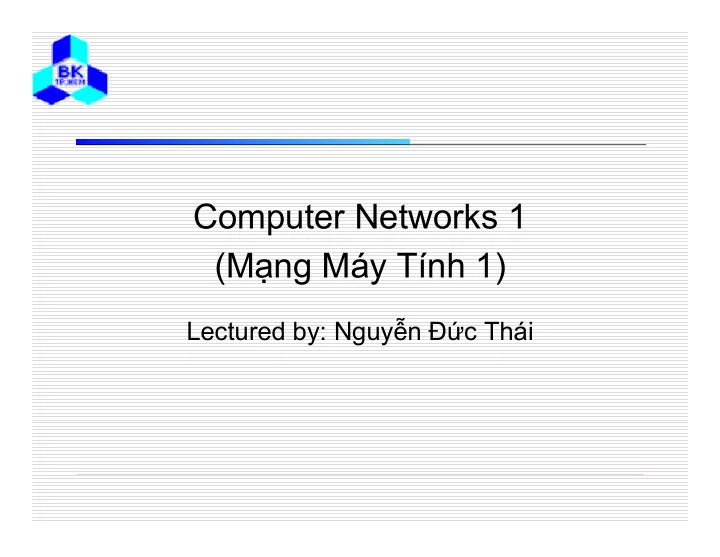

Computer Networks 1 (M ạ ng Máy Tính 1) Lectured by: Nguy ễ n Đứ c Thái
Lecture 3: Networking Technologies Reference : Chapter 4 - “ Computer Networks ”, Andrew S. Tanenbaum, 4th Edition, Prentice Hall, 2003.
Content � Channel allocation problem � Multiple access protocols � Ethernet LAN � Wireless LAN 3
Channel Allocation Problem � How to allocate a single broadcast channel amongst competing users? � Static method � Dynamic method 4
Static Channel Allocation in LANs and MANs � Each user is assigned with a equal-portion of the bandwidth � No interference between users � Simple � In efficient if there are a lot of users in the network 5
Dynamic Channel Allocation in LANs and MANs � Five key assumptions Station Model: � � The model consists of N stations � Once a frame is generated, the station blocks until the frame has been successfully transmitted Single Channel Assumption � Collision Assumption � � Collision happens when two frames are transmitted simultaneously and overlap in time (a) Continuous Time vs (b) Slotted Time � (a) Carrier Sense vs (b) No Carrier Sense � 6
Multiple Access Protocols � ALOHA � Carrier Sense Multiple Access Protocols � Collision-Free Protocols � Limited-Contention Protocols � Wavelength Division Multiple Access Protocols � Wireless LAN Protocols 7
ALOHA � Developed by Norman Abramson, in 1970s � Used ground-based radio broadcast � Pure ALOHA Use continuous time � No need for global time � � Slotted ALOHA Need global time synchronisation � 8
Pure ALOHA (1) � Users can transmit whenever they have data to send � If there is a collision, colliding frames will be damaged and will be destroyed � Senders need to wait for some time to know if there is a collision � Senders wait for a random time to transmit destroyed frames 9
Pure ALOHA (2) In pure ALOHA, frames are transmitted at completely arbitrary times. 10
Pure ALOHA (3) Vulnerable period for the shaded frame. 11
Slotted ALOHA � Time is divided into fixed interval (slot) � Each slot is equal to a frame time � Need time synchronisation among stations E.g. use a special station for timing � � Frames can only be transmitted at starts of time slots 12
ALOHA System Performances Throughput versus offered traffic for ALOHA systems. 13
Carrier Sense Multiple Access Protocols When there is data to send, a station senses � carrier first If the carrier is free, it starts sending � Else, it waits until the carrier becomes free � Common carrier sense protocols � 1-Persistent � Nonpersistent � p-Persistent � 14
Persistent and Nonpersistent CSMA Comparison of the channel utilization versus load for various random access protocols. 15
CSMA with Collision Detection � An improvement to CSMA � A station stops transmitting its frame immediate after a collision is detected to save time and bandwidth � A basis for Ethernet LAN protocol 16
CSMA with Collision Detection CSMA/CD can be in one of three states: contention, transmission, or idle. 17
Collision-Free Protocols The basic bit-map protocol. 18
Collision-Free Protocols (2) The binary countdown protocol. A dash indicates silence. 19
Ethernet � Ethernet Cabling � Manchester Encoding � The Ethernet MAC Sublayer Protocol � Switched Ethernet � Fast Ethernet � Gigabit Ethernet 20
Ethernet Cabling The most common kinds of Ethernet cabling. 21
Ethernet Cabling (2) Three kinds of Ethernet cabling. (a) 10Base5, (b) 10Base2, (c) 10Base-T. 22
Ethernet Cabling (3) Cable topologies. (a) Linear, (b) Spine, (c) Tree, (d) Segmented. 23
Ethernet Cabling (4) (a) Binary encoding, (b) Manchester encoding, (c) Differential Manchester encoding. 24
Ethernet MAC Sublayer Protocol τ Collision detection can take as long as 2 . 25
Switched Ethernet A simple example of switched Ethernet. 26
Fast Ethernet The original fast Ethernet cabling. 27
Gigabit Ethernet (a) A two-station Ethernet. (b) A multistation Ethernet. 28
Gigabit Ethernet (2) Gigabit Ethernet cabling. 29
Wireless LAN Protocols � Hidden station problem � Exposed station problem A wireless LAN. (a) A transmitting B. (b) B transmitting A. 30
Wireless LAN Protocols (2) (a) The hidden station problem. (b) The exposed station problem. 31
Wireless LAN Protocols (2) The MACA (Multiple Access with Collision Avoidance) protocol: (a) A sending an RTS to B. (b) B responding with a CTS to A. 32
The 802.11 MAC Sublayer Protocol (1) The use of virtual channel sensing using CSMA/CA 33
The 802.11 MAC Sublayer Protocol (2) A fragment burst. 34
The 802.11 Frame Structure The 802.11 data frame. 35
802.11 Services Distribution Services Association • Disassociation • Reassociation • Distribution • Integration • 36
802.11 Services Intracell Services Authentication • Deauthentication • Privacy • Data Delivery • 37
Recommend
More recommend